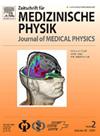利用速度选择性 ASL 结合前瞻性运动补偿进行非对比自由呼吸肝脏灌注成像。
IF 4.2
4区 医学
Q2 RADIOLOGY, NUCLEAR MEDICINE & MEDICAL IMAGING
引用次数: 0
摘要
目的:将速度选择性动脉自旋标记(VSASL)与基于导航仪的前瞻性运动补偿方法相结合,用于不使用造影剂的自由呼吸肝脏灌注测量:方法:采用锌调制速度选择性反转(sinc-VSI)脉冲作为标记和控制脉冲。为了考虑呼吸运动,采用了一个导航仪,其形式为单个梯度回波投影读数,位于膈肌沿下-上方向。在基于自旋回波 EPI 的读数的每个横向成像切片之前,都加入了导航仪和脂肪抑制。从导航仪获取运动数据并传回序列,以便实时调整切片定位。VSASL 采用的 sinc-VSI 在控制条件下没有速度选择梯度,但在标记时沿所有三个方向都有速度选择梯度。VSASL 与伪连续 ASL(pseudo-continuous ASL,pCASL)方法进行了比较,后者是通过放置在门静脉和肝动脉处的标记平面选择性标记移动的自旋:结果:利用导航信号可有效计算呼吸活动引起的运动。与屏气(BH)相比,NAV中平均肝脏体素的变异系数(CoV)明显降低,对照图像平均降低29.4±18.44%,标签图像平均降低29.89±20.83%(P 0),与NAV补偿的pCASL技术相比,NAV补偿的VSASL显示出明显更高的灌注权重:这项研究证明了将基于导航仪的前瞻性运动补偿技术与 VSASL 结合使用,在不使用造影剂、允许自由呼吸的情况下测量肝脏灌注的可行性。本文章由计算机程序翻译,如有差异,请以英文原文为准。
Non-contrast free-breathing liver perfusion imaging using velocity selective ASL combined with prospective motion compensation
Purpose
To apply velocity selective arterial spin labeling (VSASL) combined with a navigator-based (NAV) prospective motion compensation method for a free–breathing liver perfusion measurement without contrast agent.
Methods
Sinc-modulated Velocity Selective Inversion (sinc-VSI) pulses were applied as labeling and control pulses. In order to account for respiratory motion, a navigator was employed in the form of a single gradient-echo projection readout, located at the diaphragm along the inferior-superior direction. Prior to each transverse imaging slice of the spin-echo EPI based readouts, navigator and fat suppression were incorporated. Motion data was obtained from the navigator and transmitted back to the sequence, allowing real-time adjustments to slice positioning. The sinc-VSI without velocity-selective gradients during the control condition but with velocity-selective gradients along all three directions during labeling was chosen for the VSASL. The VSASL was compared with pseudo-continuous ASL (pCASL) methods, which selectively tagged the moving spins using a tagging plane placed at the portal vein and hepatic artery.
Results
The motion caused by respiratory activity was effectively computed using the navigator signal. The coefficients of variation (CoV) of average liver voxel in NAV were significantly decreased when compared to breath-hold (BH), with an average reduction of 29.4 ± 18.44% for control images, and 29.89 ± 20.83% for label images (p < 0.001). The resulting maps of normalized ASL signal (normalized to M0) showed significantly higher perfusion weightings in the NAV-compensated VSASL, when compared to the NAV-compensated pCASL techniques.
Conclusions
This study demonstrates the feasibility of using a navigator-based prospective motion compensation technique in conjunction with VSASL for the measurement of liver perfusion without the use of contrast agents while allowing for free-breathing.
求助全文
通过发布文献求助,成功后即可免费获取论文全文。
去求助
来源期刊
CiteScore
3.70
自引率
10.00%
发文量
69
审稿时长
65 days
期刊介绍:
Zeitschrift fur Medizinische Physik (Journal of Medical Physics) is an official organ of the German and Austrian Society of Medical Physic and the Swiss Society of Radiobiology and Medical Physics.The Journal is a platform for basic research and practical applications of physical procedures in medical diagnostics and therapy. The articles are reviewed following international standards of peer reviewing.
Focuses of the articles are:
-Biophysical methods in radiation therapy and nuclear medicine
-Dosimetry and radiation protection
-Radiological diagnostics and quality assurance
-Modern imaging techniques, such as computed tomography, magnetic resonance imaging, positron emission tomography
-Ultrasonography diagnostics, application of laser and UV rays
-Electronic processing of biosignals
-Artificial intelligence and machine learning in medical physics
In the Journal, the latest scientific insights find their expression in the form of original articles, reviews, technical communications, and information for the clinical practice.

 求助内容:
求助内容: 应助结果提醒方式:
应助结果提醒方式:


